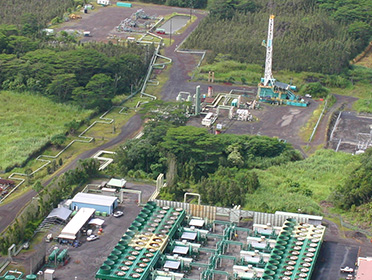Renewable Energy Sources
Geothermal
Geothermal energy taps volcanic heat to make electricity

Geothermal energy comes from volcanic heat stored beneath the earth's surface. Underground reservoirs of water heated by volcanic activity can be tapped for steam to generate electricity. On Hawaii Island, Puna Geothermal Venture operates an advanced binary-cycle power plant. The heat from hot water in a heat exchanger generates vapor from a working fluid with a low-boiling point. This vapor drives a turbine to produce electricity. The water, which never comes in contact with the working fluid, is then injected back into the ground to reheat.
Current Geothermal Contributions
- Hawaii Island purchases 38 MW of power from the Puna Geothermal Venture plant. PGV has permits allowing it to expand another 22 MW in the future at its current location. Learn more about Puna Geothermal Venture.
- Possible geothermal energy resources may exist in West Hawaii and on the island of Maui.
- No geothermal resources have been identified on Oahu that could be tapped for electricity.
Historical Contributions to Geothermal Energy
- For eight years, Hawaiian Electric operated the Hawaii Geothermal Energy Project-Wellsite A, a 3-megawatt power plant on Hawaii Island.
- In the 1980s, the "Hawaii Deep Water Cable" study was funded by the U.S. Department of Energy and the State of Hawaii Department of Business, Economic Development and Tourism. Hawaiian Electric was the prime contractor for the study with the actual research work done by a number of subcontractors.
Completed in 1990, the multi-year research project concluded that transmitting geothermal electricity from Hawaii Island to Oahu was technically feasible. However, the State did not pursue the project due to high costs and possible environmental impacts related to the project at a time when oil prices remained relatively low.







